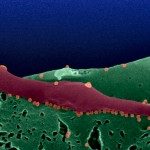Link to Pubmed [PMID] – 25701575
Bioinformatics 2015 Jul;31(13):2141-50
MOTIVATION: The study of RNA virus populations is a challenging task. Each population of RNA virus is composed of a collection of different, yet related genomes often referred to as mutant spectra or quasispecies. Virologists using deep sequencing technologies face major obstacles when studying virus population dynamics, both experimentally and in natural settings due to the relatively high error rates of these technologies and the lack of high performance pipelines. In order to overcome these hurdles we developed a computational pipeline, termed ViVan (Viral Variance Analysis). ViVan is a complete pipeline facilitating the identification, characterization and comparison of sequence variance in deep sequenced virus populations.
RESULTS: Applying ViVan on deep sequenced data obtained from samples that were previously characterized by more classical approaches, we uncovered novel and potentially crucial aspects of virus populations. With our experimental work, we illustrate how ViVan can be used for studies ranging from the more practical, detection of resistant mutations and effects of antiviral treatments, to the more theoretical temporal characterization of the population in evolutionary studies.
AVAILABILITY AND IMPLEMENTATION: Freely available on the web at http://www.vivanbioinfo.org
CONTACT: : nshomron@post.tau.ac.il
SUPPLEMENTARY INFORMATION: Supplementary data are available at Bioinformatics online.


